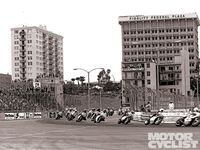The 1976 United States Grand Prix West in Long Beach, California, was the first points-paying Formula One race in the Western United States since 1960 at not-too-distant Riverside. Roadracing fans flocked from all over to see F1 cars race through the city streets and, taking advantage of a captive audience, Kawasaki sponsored a motorcycle exhibition race sanctioned by the FIM. For the first time, Gary Nixon, Yvon Duhamel and others took to the streets of an American city to drum up support for roadracing on two wheels. That demonstration was a success, and the following year the AMA scheduled an invitational, non-points-paying race as part of the USGP weekend.
The original layout for the Long Beach road course was both challenging and unforgiving due to the ever-present concrete barriers that lined the circuit. Huge elevation changes as the track rose up to Ocean Boulevard and then dropped off in the midst of a right-hand curve at the “Linden Leap” made the course even riskier. It is hard to imagine a less bike-friendly environment than those concrete canyons, but concepts of circuit safety and adequate runoff were just emerging as major issues for riders.
To address these concerns, the AMA asked the organizers to place foam-rubber blocks at strategic locations. “That place was like racing in a tunnel,” remembers Gene Romero. “There was cement on both sides of you. When you came out of the Hairpin onto the Shoreline Straight [which curves to the right], you’d just keep banging off gears, but you couldn’t see that far ahead of you. I was just hoping that nobody would be stopped there!”
The field was deep with talent: Romero, Nixon, Skip Aksland, Dale Singleton, Mike Kidd, Gary Scott, Wes Cooley, David Emde, Mike Baldwin and Roberto Pietri joined the others on a thundering herd of 15 Yamaha TZ750s. The sole exception was reigning 500cc World Champion Barry Sheene, who arrived on his Heron Texaco Suzuki RG500, determined to rain on the Americans’ parade.
Romero burst into the early lead but overshot Turn One on lap two, then followed Aksland to the checkered flag. The battle for third raged between GP great Sheene and future GP competitor Baldwin until a broken expansion chamber cost the latter a place on the podium.
No motorcycle race was scheduled for ’78, and while sidecar racing lasted a few years beyond that, there was no talk of two-wheelers again until ’81, when there was a 250cc exhibition race. But ultimately, the AMA decided that the streets of Long Beach were simply too dangerous for motorcycles. Today, the most memorable portions of that historic circuit are lost to history, but memories remain of the days when some of the greatest riders of the time shared the track with the world's greatest drivers. MC











/cloudfront-us-east-1.images.arcpublishing.com/octane/FZXHNOQRNVA3BIDWAF46TSX6I4.jpg)
/cloudfront-us-east-1.images.arcpublishing.com/octane/JRSFLB2645FVNOQAZCKC5LNJY4.jpg)
/cloudfront-us-east-1.images.arcpublishing.com/octane/ITNLTIU5QZARHO733XP4EBTNVE.jpg)
/cloudfront-us-east-1.images.arcpublishing.com/octane/VZZXJQ6U3FESFPZCBVXKFSUG4A.jpg)
/cloudfront-us-east-1.images.arcpublishing.com/octane/QCZEPHQAMRHZPLHTDJBIJVWL3M.jpg)
/cloudfront-us-east-1.images.arcpublishing.com/octane/HXOUJXQWA5HBHGRO3EMJIGFMVI.jpg)

/cloudfront-us-east-1.images.arcpublishing.com/octane/3TIWWRV4JBBOLDVGRYECVVTA7Y.jpg)
/cloudfront-us-east-1.images.arcpublishing.com/octane/KIX5O23D5NAIBGFXBN3327DKZU.jpg)
/cloudfront-us-east-1.images.arcpublishing.com/octane/7GJYDUIPXRGMTMQKN6ONYOLBOU.jpg)
/cloudfront-us-east-1.images.arcpublishing.com/octane/MUQLOVLL2ZDGFH25ILABNBXKTI.jpg)
/cloudfront-us-east-1.images.arcpublishing.com/octane/TNOU5DNE2BC57MFPMGN2EIDXAM.jpg)
/cloudfront-us-east-1.images.arcpublishing.com/octane/GTCXACQGJ5HAPDTGWUQKDEH44E.jpg)
/cloudfront-us-east-1.images.arcpublishing.com/octane/S35YGSEMEZB4BLTDJTSZPF4GLA.jpg)
/cloudfront-us-east-1.images.arcpublishing.com/octane/5UOT6HPX2JFMRJAX6EH45AR4MQ.jpg)
/cloudfront-us-east-1.images.arcpublishing.com/octane/OKWOJWAKP5EP3OACCRRWPCIX2Q.jpg)
/cloudfront-us-east-1.images.arcpublishing.com/octane/2WF3SCE3NFBQXLDNJM7KMXA45E.jpg)
/cloudfront-us-east-1.images.arcpublishing.com/octane/G4MG6OUCJNBSHIS2MVVOTPX65E.jpg)
/cloudfront-us-east-1.images.arcpublishing.com/octane/IIGGWFOTOJGB7DB6DGBXCCMTDY.jpg)
/cloudfront-us-east-1.images.arcpublishing.com/octane/QSTCM6AVEZA5JJBUXNIQ3DSOF4.jpg)
/cloudfront-us-east-1.images.arcpublishing.com/octane/U4I7G625B5DMLF2DVIJDFZVV6M.jpg)
/cloudfront-us-east-1.images.arcpublishing.com/octane/B6XD6LS6IVCQPIU6HXDJSM3FHY.jpg)
/cloudfront-us-east-1.images.arcpublishing.com/octane/ICL63FEDDRDTTMINYICCEYGMDA.jpg)
/cloudfront-us-east-1.images.arcpublishing.com/octane/FCGZHQXRBZFLBAPC5SDIQLVF4I.jpg)